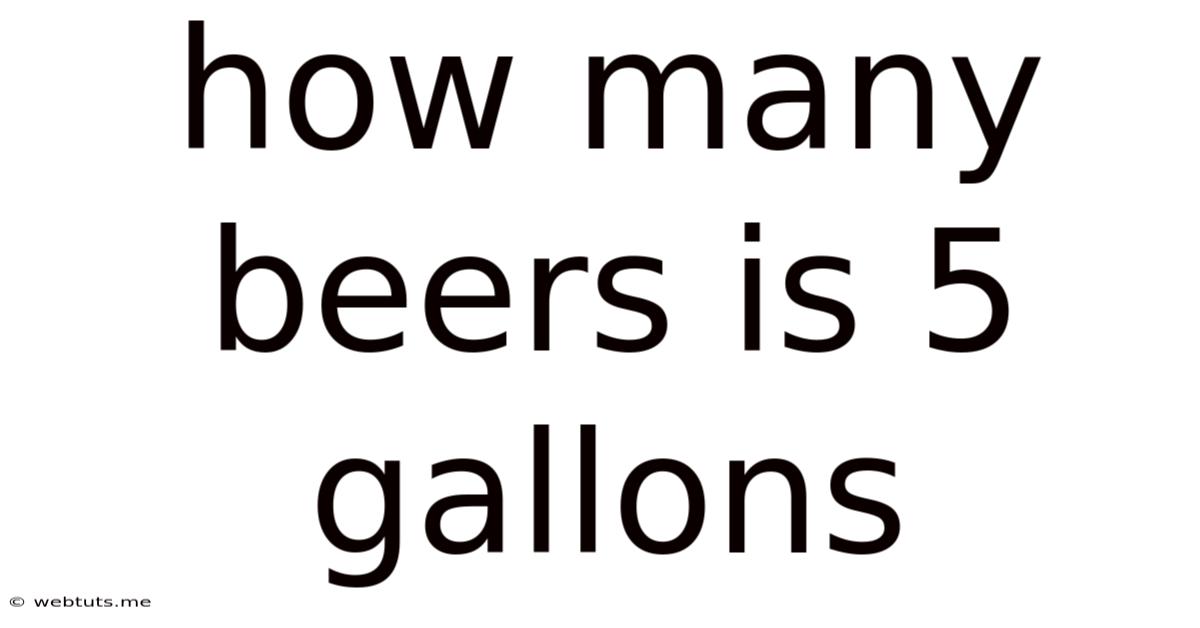How Many Beers Is 5 Gallons
Webtuts
May 11, 2025 · 4 min read

Table of Contents
How Many Beers is 5 Gallons? A Comprehensive Guide to Homebrewing Math
So, you're diving into the exciting world of homebrewing, and you've got yourself a shiny new 5-gallon fermenter. But now the crucial question arises: how many beers can you actually make with 5 gallons? The answer, as you might expect, isn't a simple number. It depends on several factors. This comprehensive guide will break down the calculations, explore the variables, and ultimately help you accurately estimate your 5-gallon brewing potential.
Understanding the Basics: Gallons, Cases, and Bottles
Before diving into the specifics, let's clarify some fundamental units:
- Gallons (gal): The standard unit for measuring the volume of your beer batch. A 5-gallon fermenter is the most common size for homebrewers.
- Bottles: The individual containers holding your finished beer. Standard sizes include 12-ounce (355ml) and 22-ounce (650ml) bottles.
- Cases: Usually contain 12 bottles, although this can vary.
The relationship between gallons and bottles is crucial for determining how many beers you get from a 5-gallon batch. This depends entirely on your bottle size.
The Variables Affecting Your Beer Yield
The number of beers you get from 5 gallons isn't just a straightforward conversion. Several crucial factors influence the final outcome:
1. Bottle Size
This is the most straightforward variable. A 5-gallon batch will yield significantly more 12-ounce bottles than 22-ounce bottles. The calculation is as follows:
-
12-ounce bottles: 5 gallons * 128 ounces/gallon / 12 ounces/bottle ≈ 53.3 bottles. This translates to roughly 4.4 cases (53.3 bottles / 12 bottles/case).
-
22-ounce bottles: 5 gallons * 128 ounces/gallon / 22 ounces/bottle ≈ 29.1 bottles. This is approximately 2.4 cases.
2. Brewing Losses
This is a critical aspect often overlooked by beginners. Throughout the brewing process, you'll inevitably experience some loss of liquid. These losses occur at various stages:
-
Trub and Yeast: During fermentation, sediment (trub) and yeast settle at the bottom of the fermenter. You won't bottle this, resulting in a loss of about a half-gallon or more.
-
Bottling Losses: Some beer inevitably gets left behind in the bottling bucket or siphon.
-
Evaporation: A small amount of liquid might evaporate during the boiling and fermentation stages.
These losses combined can easily account for 0.5 to 1 gallon, or even more, depending on your technique. Therefore, instead of starting with 5 gallons, it's more realistic to work with an effective brewing volume of 4 to 4.5 gallons.
3. Recipe Efficiency
Different beer recipes have varying efficiencies. Efficiency refers to how well your brewing process converts the grains into fermentable sugars. A higher efficiency means more beer from the same amount of grain. While recipe efficiency won't directly change your final volume in gallons, a lower efficiency could mean less alcohol by volume (ABV), and thus you're producing a slightly weaker beer from the same starting volume. This impacts the overall “strength” and “number of beers” perceptually but not necessarily numerically.
4. Priming Sugar
When bottling, you add priming sugar to carbonate your beer. This small addition increases the final volume slightly, negating some of the bottling losses. This increase is minimal and usually doesn't significantly impact the final bottle count.
Calculating Your Beer Yield: A Step-by-Step Approach
Let's create a more precise calculation considering brewing losses:
-
Account for Losses: Assume a conservative loss of 1 gallon due to trub, yeast, and bottling. This leaves you with an effective brewing volume of 4 gallons.
-
Choose your Bottle Size: Let's stick with 12-ounce bottles for this example.
-
Perform the Calculation: 4 gallons * 128 ounces/gallon / 12 ounces/bottle = 42.7 bottles. This is approximately 3.6 cases.
-
Consider Variations: Remember, this is an estimate. Your actual yield could be slightly higher or lower depending on your specific brewing process and efficiency.
Beyond the Numbers: Optimizing Your 5-Gallon Brew
While knowing how many beers you'll get is important, focusing solely on quantity overlooks the quality and enjoyment aspects of homebrewing. Here's how to optimize your 5-gallon batch:
-
Recipe Selection: Choose recipes appropriate for your 5-gallon system. Scaling down a 10-gallon recipe will be challenging and may result in inaccuracies. Many recipes are specifically designed for 5-gallon batches.
-
Sanitation: Meticulous sanitation prevents infections that can ruin your entire batch. A spoiled 5-gallon batch is a far greater loss than a slightly lower yield.
-
Process Refinement: Practice consistent brewing techniques to minimize losses and improve efficiency over time. The more you brew, the better you'll become at managing these variables.
-
Experimentation: Homebrewing is all about experimentation! Once comfortable with the basics, try different recipes, styles, and techniques to discover your preferences.
Conclusion: It's More Than Just the Numbers
While the initial question of "How many beers is 5 gallons?" leads to a relatively simple calculation, a deeper understanding of the variables involved unlocks a more nuanced perspective. Homebrewing is a craft that combines science, precision, and creativity. The focus shouldn't solely be on the number of bottles produced, but on the quality, satisfaction, and enjoyment of the brewing process itself. Now get brewing! Enjoy the process and the rewards of your delicious, handcrafted 5-gallon beer batch. Remember to always brew responsibly and drink in moderation.
Latest Posts
Latest Posts
-
How Many Feet Are In A Liter
May 12, 2025
-
How Many Weeks Is 18 Years
May 12, 2025
-
How Many Cups In A Five Pound Bag Of Flour
May 12, 2025
-
Weight Of 6 Rebar Per Foot
May 12, 2025
-
140 Cm To Inches And Feet
May 12, 2025
Related Post
Thank you for visiting our website which covers about How Many Beers Is 5 Gallons . We hope the information provided has been useful to you. Feel free to contact us if you have any questions or need further assistance. See you next time and don't miss to bookmark.